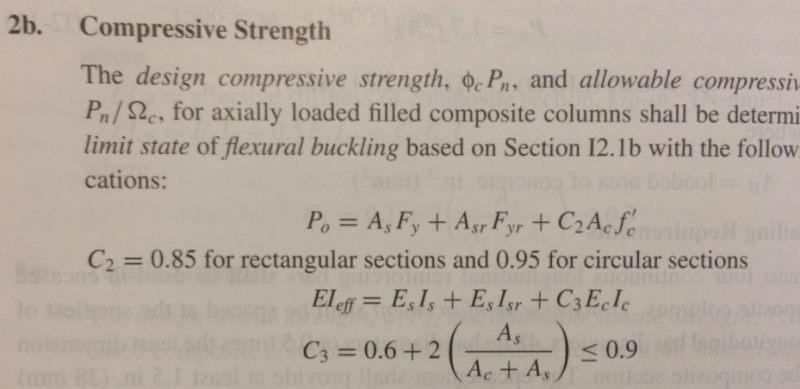IngDod
Structural
- Apr 13, 2013
- 98
Greetings,
I am trying to ascertain whether filling HSS columns with concrete in a steel two-story building would have any significant impact in reducing lateral deflections of the structure. The idea is to use filled HSS tubes instead of a bracing system, since that would limit the architecture considerably. As it is, the structure is within parameters for seismic and wind loads; the problem is mainly the perception for occupants. Columns are 155x155mm HSS and all of them have ample capacity for the structure, the demand ratio is below 70% in all cases (even seismic). Problem is too much sway. I’ve read AISC specification and CIDECT guides regarding filled HSS, while I have a moderate understanding of the axial and flexural behavior of such system I have not found any specific information regarding the impact on deflection.
My intuition tells me that a HSS filled column should be very stiff compared to the empty HSS, however I wonder about cracking in the concrete and how this would affect its effectiveness. And whether using vertical rebar alone (no ties) would be enough to avoid excessive cracking of the concrete and perhaps gain more stiffness than using only concrete. My understanding is that the HSS capacity alone can be used to resist the shear, however the steel column can bend a good deal more than the concrete inside it so I have some doubts in this area (should I use shear capacity of the unreinforced concrete section instead?).
In the region I am in, (outside U.S) the common practice is to use HSS columns and beams ,as I and H beams are not available in the market. I’m trying to come up with a way to control sway while still using the “standard practice” in my area. In previous projects I have used bracing in one direction and rectangular HSS columns in another to mitigate this problems. However I am now faced with a situation where only square columns and no braces are possible. Also in order to comply with seismic provisions I have to fill the HSS tubes anyway (the walls are too thin for the sections to be classified as compact on their own).
I have seen several situations in which buildings have considerable sway during the construction phase due to the relative flexibility (thin walls) of square HSS sections commonly used for columns (An hardly anyone fills them with concrete since they don’t know or don’t care about seismic provisions apparently). The sway in these buildings only becomes reasonable after the walls (made of clay masonry blocks) are erected, but I don’t believe this to be an acceptable practice since these walls are not supposed to be loadbearing and I worry about future cracks in the walls or windows.
My question specifically:
Could filling HSS tubes provide enough stiffness to the columns to be worthwhile?
I am trying to ascertain whether filling HSS columns with concrete in a steel two-story building would have any significant impact in reducing lateral deflections of the structure. The idea is to use filled HSS tubes instead of a bracing system, since that would limit the architecture considerably. As it is, the structure is within parameters for seismic and wind loads; the problem is mainly the perception for occupants. Columns are 155x155mm HSS and all of them have ample capacity for the structure, the demand ratio is below 70% in all cases (even seismic). Problem is too much sway. I’ve read AISC specification and CIDECT guides regarding filled HSS, while I have a moderate understanding of the axial and flexural behavior of such system I have not found any specific information regarding the impact on deflection.
My intuition tells me that a HSS filled column should be very stiff compared to the empty HSS, however I wonder about cracking in the concrete and how this would affect its effectiveness. And whether using vertical rebar alone (no ties) would be enough to avoid excessive cracking of the concrete and perhaps gain more stiffness than using only concrete. My understanding is that the HSS capacity alone can be used to resist the shear, however the steel column can bend a good deal more than the concrete inside it so I have some doubts in this area (should I use shear capacity of the unreinforced concrete section instead?).
In the region I am in, (outside U.S) the common practice is to use HSS columns and beams ,as I and H beams are not available in the market. I’m trying to come up with a way to control sway while still using the “standard practice” in my area. In previous projects I have used bracing in one direction and rectangular HSS columns in another to mitigate this problems. However I am now faced with a situation where only square columns and no braces are possible. Also in order to comply with seismic provisions I have to fill the HSS tubes anyway (the walls are too thin for the sections to be classified as compact on their own).
I have seen several situations in which buildings have considerable sway during the construction phase due to the relative flexibility (thin walls) of square HSS sections commonly used for columns (An hardly anyone fills them with concrete since they don’t know or don’t care about seismic provisions apparently). The sway in these buildings only becomes reasonable after the walls (made of clay masonry blocks) are erected, but I don’t believe this to be an acceptable practice since these walls are not supposed to be loadbearing and I worry about future cracks in the walls or windows.
My question specifically:
Could filling HSS tubes provide enough stiffness to the columns to be worthwhile?

